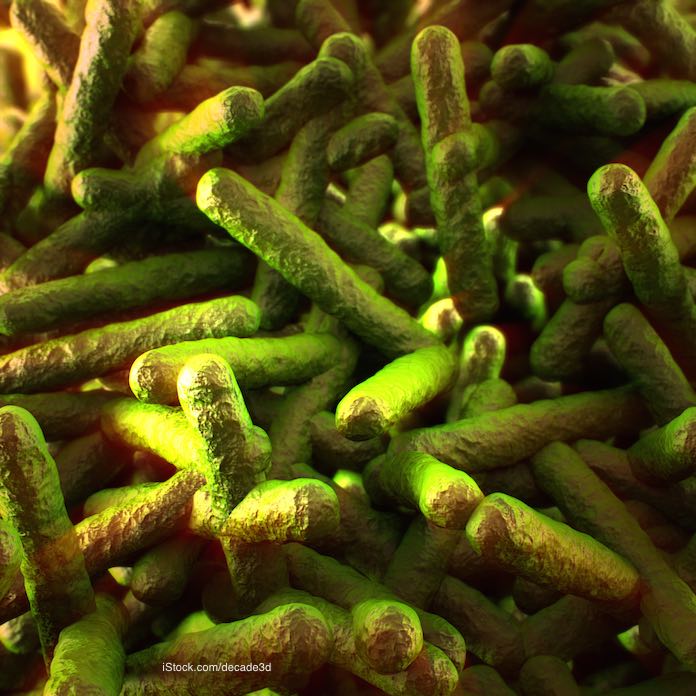Listeria poisoning is an infection of the body with Listeria bacteria, more specifically Listeria monocytogenes (or L. mono, for short). This kind of infection is called listeriosis.

The first signs of infection might include:
- Diarrhea
- Nausea
- Muscle aches
- Fever
The incubation period—the time between consumption of the contaminated food and first signs of illness—varies depending on the type of Listeria infection. Listeria illnesses can range from mild to “invasive.”
For otherwise healthy people, Listeria usually presents as a “stomach bug.” Mild infections are rarely diagnosed, because people may not even require medical care. In these circumstances, the incubation period is shorter: 24 hours, on average.
However, in people that are young, elderly, pregnant, or otherwise immunocompromised, a Listeria infection can be far more dangerous. Listeria can infect the nervous system (Listeria meningitis), the blood (bacteremia), joints, and, for pregnant women, cause harm to the developing baby.
Symptoms of invasive Listeria infections can include:
- Headache
- Stiff neck
- Confusion
- Loss of balance
- Convulsions
These are hallmark symptoms of meningitis. This type of Listeria infection has an average incubation period of 9 days, but it can vary from 1-14 days.
Pregnant women are at a greater risk for Listeria infections because their immune systems are weaker. Expectant moms are 20 times more likelyto be infected with Listeria than the general population. However, pregnant women may not notice many symptoms themselves—potentially mild gastrointestinal symptoms—but the Listeria infection can be devastating for the baby. In early pregnancy, Listeria is known to cause miscarriage. Later in pregnancy, Listeria can cause preterm labor and even fetal death. Newborns infected with the disease may show signs of difficult breathing, fever, rash, jaundice, a poor appetite, and excessive sleepiness. For pregnant women, the incubation period is often longer, ranging from 17-67 days.
Listeria can be diagnosed by taking samples of spinal fluid, blood, placenta, or other bodily fluids. The sample is sent to a laboratory for a bacterial culture.
Listeria is widely regarded as one the deadliest foodborne pathogens, with about 20% of those infected dying from the illness. Those that suffer meningitis and survive can be left with long-term complications.
How do you get Listeria?
A person usually becomes infected with Listeria by eating contaminated food. While many different kinds of food can become contaminated with Listeriawhile being processed (i.e., while at a food manufacturing or distribution facility), some foods are considered higher risk, meaning that these foods are more likely to harbor Listeria monocytogenes. These foods include:
- Deli meats
- Hot dogs
- Pates or meat spreads
- Raw or unpasteurized milk or other diary products
- Soft cheeses made with unpasteurized milk
- Smoked seafood
- Sprouts
Though these types of foods are particularly risky, Listeria outbreaks have been caused by things like cantaloupes, ice cream, caramel apples, bagged lettuce, and celery, which would not otherwise be considered particularly risky.
Listeria is particularly dangerous because it can grow in cold temperatures—like refrigerators—and freezing does not kill the bacteria. While Listeria can be killed by cooking at a high temperature, since many of the foods that may contain the bacteria are consumed raw, the primary way to prevent Listeriaoutbreaks is to prevent contamination in the first place.
What is being done to prevent Listeria contamination andListeria outbreaks?
Because Listeria is so deadly, federal regulators are cracking down on how food companies manage their Listeria risk, including how Listeria is tested for (in the food processing environment) and what steps must be taken to prevent it. Under the Food Safety Modernization Act, the FDA has implemented stricter rules regarding Listeria testing and prevention, which should help reduce the number of outbreaks.
For example, the FDA specifically provides a plan for testing for Listeria in the food processing environment, and has issued in-depth draft guidance to the industry for how manufacturers can prevent the bacteria from entering the consumer food supply.
Listeria prevention has also caught the attention of the food industry, with food safety experts working to develop plans to “seek and destroy” Listeria in processing environments.
But a huge part of Listeriaprevention starts with understanding past outbreaks of listeriosis. Technology like whole genome sequencing can help detect clusters of Listeria infections, even if only two people have gotten sick, which may point to a common source of the bacteria. When public health officials are able to detect outbreaks and determine a common source, regulators and food companies alike are more able to learn.




